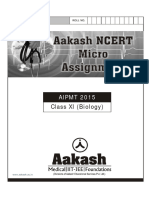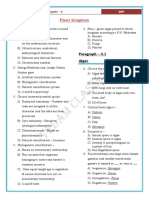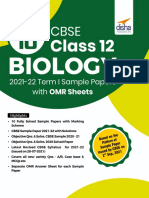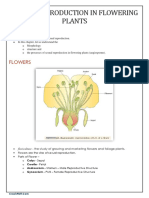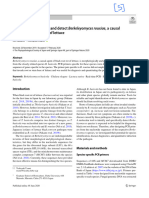12 Biology Notes Ch10 Microbes in Human Welfare
12 Biology Notes Ch10 Microbes in Human Welfare
Uploaded by
Yash GuptaCopyright:
Available Formats
12 Biology Notes Ch10 Microbes in Human Welfare
12 Biology Notes Ch10 Microbes in Human Welfare
Uploaded by
Yash GuptaOriginal Description:
Copyright
Available Formats
Share this document
Did you find this document useful?
Is this content inappropriate?
Copyright:
Available Formats
12 Biology Notes Ch10 Microbes in Human Welfare
12 Biology Notes Ch10 Microbes in Human Welfare
Uploaded by
Yash GuptaCopyright:
Available Formats
CBSE
Class 12 Biology
Revision Notes
CHAPTER- 10
MICROBES IN HUMAN WELFARE
Microbes are diverse-protozoa, bacteria, fungi and microscopic plants viruses, viroid and
also prions that are proteinacious infectious agents. They are found everywhere on earth
ranging from soil, air water and some inhabitable places.
Bacteria and fungi can be grown on nutritive media to form colonies, which can be seen by
necked eyes and very useful in study of microorganisms.
Microbes cause many diseases in human beings, plants and animals. Several microorganisms
are useful to man in diverse ways.
Microbes in household products
a. Microorganisms like Lactobacillus and other commonly called lactic acid bacteria (LAB)
grow in milk and convert it to curd. The LAB produces acids that coagulate and partially
digest the milk proteins. It also improves its nutritional quality by increasing vitamin B12. In
our stomach too, the LAB play very beneficial role in checking disease causing microbes.
b. The dough is used for making foods such as dosa and idli is fermented by bacteria. The
puffed-up appearance of dough is due to the production of CO2 gas. The dough used for
making bread is fermented using baker’s yeast (Saccharomyces cervisiae).
c. Cheese, is one of the oldest food items in which microbes were used. The large holes in
‘Swiss cheese’ are due to production of a large amount of CO2 by a bacterium
named Propionibacterium sharmanii. The ‘Roquefort cheese’ is ripened by growing a specific
fungus on them for a particular flavour.
Microbes in industrial production
A number of products like beverages and antibiotics involve uses of microbes. Production on
large scale requires growing microbes in very large vessels called fermenters.
Material downloaded from myCBSEguide.com. 1 / 6
a. Fermented Beverages- Saccharomyces cerevisiae used for bread-making and commonly
called brewer’s yeast, is used for fermenting malted cereals and fruit juices, to
produce beverages like wine, bear, whisky and rum.. Wine and bear are produced without
distillation whereas whisky, brandy and rum are produced by distillation of the fermented
broth.
b. Antibiotics- they are chemical substances produced by some microbes and can kill or
retard the growth of other microbes. Penicillin was first antibiotic to be discovered.
Antibiotics have great improved our capacity to treat deadly diseases such as plague,
whooping cough, diphtheria and leprosy.
c. Chemical, Organic acids , Enzymes and other Bioactive Molecules are commercially
produced by microbes.
Chemicals :
Aspergillus niger (fungus) – Citric acid
Acetobacter aceti (bacterium) – Acetic acid
Clostridium butylicum (bacterium) – Butyric acid
Lactobacillus (bacterium) – Lactic acid
Saccharomyces cerevisiae – Ethanol
Enzymes:
Lipase – used in laundry detergents
Material downloaded from myCBSEguide.com. 2 / 6
Pectinase and protease – used in bottled juices
Streptokinase (Streptococcus bacterium) – used as clot buster (to remove clots)
Bioactive molecules:
Cyclosporin A (Trichoderma polysporum fungi) – used as immunosuppressive agent
(for organ transplant patients).
Statins (Monascus purpureus yeast) – used as blood cholesterol lowering agents.
Microbes in sewage Treatment
Municipal waste water (sewage) contains large amount of organic matter and microbes
which are pathogenic and cannot be discharged into natural water bodies like rivers and
streams.
Sewage is treated in sewage treatment plant to make it less polluting by using heterotrophic
microbes naturally present in sewage. Sewage treatment is done in two stages-
In primary treatment, floating debris is removed by sequential filtration. Grit (soil and small
pebbles) are removed by sedimentation.
Secondary treatment or biological treatment involves passing of primary effluents in large
aeration tank to help the growth of aerobic microbes into flocs (masses of bacteria associated
with fungal filaments to form mesh like structures). These microbes increase the
consumption of organic wastes and decrease the BOD (biological oxygen demand)of the
effluents.
BOD is the amount of oxygen that would be consumed if all the organic matter in one litre of
water were oxidised by bacteria. It measures the amount of organic matter present in the
Material downloaded from myCBSEguide.com. 3 / 6
water. Greater the BOD of water more it is polluted.
Once the BOD of sewage or waste water is reduced, the effluent is then passed into a
settling tank where the bacterial ‘flocs’ are allowed to sediment. This sediment is
called activated sludge.
Sludge is passed into large tanks called anaerobic sludge digesters in which anaerobic
bacteria digest the bacteria and fungi in the sludge and produce mixture of gas called biogas,
which is a mixture of methane, hydrogen sulphide and carbon dioxide.
The effluents from the secondary treatment plant are released into water bodies.
Microbes in Production of Biogas
Biogas is a mixture of gases produced by the microbial activity that can be used as fuel.
Certain bacteria that grows anaerobically on cellulosic material produce large amount of
methane along with CO2and H2. These bacteria are collectively called methanogens
(Methanobacterium).
Biogas Plant – the excreta of cattle (gobar) is rich in methanogens bacteria and is used for
generation of biogas also called as gobar gas.
The technology of biogas production was developed in India mainly due to the efforts
of Indian Agricultural Research Institute (IARI) and Khadi and Village Industries
Commission (KVIC).
Biogas plant consists of a concrete tank in which bio-wastes are collected and slurry of dung
Material downloaded from myCBSEguide.com. 4 / 6
is fed.
A floating cover is placed over digester that moves upward when gas is produced. The gas
produced is removed and supplied through an outlet pipe for consumption.
The spent slurry is removed through another outlet and used as fertilisers. Biogas plant is
more often build in rural areas as large amount of cattle dug is available easily.
Microbes as Biocontrol agent
Biocontrol means use of biochemical method for controlling plant disease and pests. The
chemical used as pesticides and insecticides are harmful to human beings and animals.
Biological control of pests and disease is a method of controlling pest on natural prediction
rather than chemicals. The organic farmer creates a system where the pests are not
eradicated but kept at manageable level by complex system of check and balance within the
living and vibrant ecosystem. For example, the Ladybird and Dragonflies are used to get rid
of aphids and mosquitoes respectively. On brassicas and fruit tree, to control butterfly
caterpillars bacteria Bacillus thuringiensis is used.
Biological control developed for use in the treatment of plant disease is the fungus
Trichoderma. Trichoderma are free-living fungi that are very common in the root systems
that control several plant pathogens.
Baculoviruses are pathogens that attack insects and other arthropods. The majority of
baculoviruses used as biological control agents are in the genus
Nucleopolyhedrovirus. These viruses are excellent candidates for species-specific,
narrow spectrum insecticidal applications.
Microbes as Bio fertilisers
Bio fertilisers are organisms that enrich the nutrient quality of the soil. The main sources
includes bacteria, fungi and cyanobacteria.
The root nodule formed by Rhizobium bacteria on root of leguminous plants increase the
nitrogen level of soil, necessary for various metabolic processes. Azotobacter and
Azospirillum are free living bacteria that live in soil and fix atmospheric nitrogen into
organic forms.
Material downloaded from myCBSEguide.com. 5 / 6
Symbiotic association of fungi with angiosperm plants (mycorrhiza) also increase the fertility
of soil. Glomus form mycorrhiza that absorbs phosphorus from the soil and passes it to the
plant. These microbes also provide benefits like resistance to root-borne pathogens,
tolerance to salinity and drought.
Cyanobacteria (Nostoc, Anabaena), an autotrophic microbes found in aquatic and terrestrial
environment fix atmospheric nitrogen. In paddy field this acts as important bio-fertiliser.
Blue green algae also add organic matter to the soil and increase its fertility.
Material downloaded from myCBSEguide.com. 6 / 6
You might also like
- 11th Biology NCERT Microassignments All Chapters - FinalDocument58 pages11th Biology NCERT Microassignments All Chapters - FinalKayu KayathriNo ratings yet
- Xam Idea Biology Class 12 Term 1 MCQDocument158 pagesXam Idea Biology Class 12 Term 1 MCQSahil GuptaNo ratings yet
- Xii Biology Assertion-And-ReasoningDocument18 pagesXii Biology Assertion-And-ReasoningKiran RaoNo ratings yet
- Biology Class 12 Diagram Based QuestionsDocument40 pagesBiology Class 12 Diagram Based QuestionsJanani KaNo ratings yet
- Biology Class 12 NotesDocument46 pagesBiology Class 12 Notesbalamuruganbro45No ratings yet
- 11 Biology Notes ch03 Plant Kingdom PDFDocument5 pages11 Biology Notes ch03 Plant Kingdom PDFakash guptaNo ratings yet
- CBSE Class 12 Biology Revision Notes Chapter 6 Molecular Basis of InheritanceDocument10 pagesCBSE Class 12 Biology Revision Notes Chapter 6 Molecular Basis of InheritancesahanaNo ratings yet
- Cbse Class 12 Sexual Reproduction in Flowering Plants Mind MapDocument1 pageCbse Class 12 Sexual Reproduction in Flowering Plants Mind MapDhiraj KUmarNo ratings yet
- Notes: - Reproduction in Organisms, For Class 12Document18 pagesNotes: - Reproduction in Organisms, For Class 12Subho BhattacharyaNo ratings yet
- Class 11 Biology Notes Chapter 3 Studyguide360Document11 pagesClass 11 Biology Notes Chapter 3 Studyguide360ANo ratings yet
- Molecular Basis of Inheritance: By: Dr. Anand ManiDocument130 pagesMolecular Basis of Inheritance: By: Dr. Anand ManiIndu Yadav100% (3)
- Class 11 Biology NotesDocument150 pagesClass 11 Biology NotesreilyshawnNo ratings yet
- Class 12 Chemistry Sample Paper Set 1Document32 pagesClass 12 Chemistry Sample Paper Set 1Artham Resources100% (1)
- Chapter 8 Human Health and Disease Unsolved Important Questions Class 12Document10 pagesChapter 8 Human Health and Disease Unsolved Important Questions Class 12Priyanka KumariNo ratings yet
- Biology Practical For Class 11 CBSEDocument13 pagesBiology Practical For Class 11 CBSEHarmanpreet SinghNo ratings yet
- Chemistry DishaDocument164 pagesChemistry DishaAaløk ßhaskarNo ratings yet
- MCQs On New Families Added NEET 2024Document2 pagesMCQs On New Families Added NEET 2024brzilserver57No ratings yet
- G2 Handwritten Notes (NEET)Document2 pagesG2 Handwritten Notes (NEET)Chirag Rajpal100% (1)
- Arihant CBSE ChaterWise Solved Paper Chemistry 12 2019-2020Document502 pagesArihant CBSE ChaterWise Solved Paper Chemistry 12 2019-2020poliovacjieNo ratings yet
- Aakash Model Test Papers Solutions XI Half Biology PDFDocument26 pagesAakash Model Test Papers Solutions XI Half Biology PDFSuguna RajaguruNo ratings yet
- Biology Pocket Book Class 12 - Dr. Anand ManiDocument49 pagesBiology Pocket Book Class 12 - Dr. Anand Manishivamrajbhar9511100% (1)
- Xam Idea Maths 12thDocument432 pagesXam Idea Maths 12thAaløk ßhaskarNo ratings yet
- Chemistry Blue Print Ii Puc 2024Document3 pagesChemistry Blue Print Ii Puc 2024KAUSTUBH RAO KANDULA100% (1)
- XII - XAMIDEA - BIOLOGY - Organisms & PopulationsDocument38 pagesXII - XAMIDEA - BIOLOGY - Organisms & Populationskeren spamzNo ratings yet
- Sexual Reproduction in Flowering Plants-Mcq-Neet Class-Xii BiologyDocument6 pagesSexual Reproduction in Flowering Plants-Mcq-Neet Class-Xii BiologyAnjaliNo ratings yet
- Biology Class 11 & 12 Class Notes For NEETDocument241 pagesBiology Class 11 & 12 Class Notes For NEETAfsana100% (1)
- DPP XI Chapter - 3 Palnt Kingdom 17Document17 pagesDPP XI Chapter - 3 Palnt Kingdom 17Riya Mondal100% (1)
- 8 Human Health N Disease-NotesDocument5 pages8 Human Health N Disease-NotesAnanth DharanidharanNo ratings yet
- Biotechnology Principles and ProcessesDocument5 pagesBiotechnology Principles and ProcessesSoumyadip HazariNo ratings yet
- Principles of Inheritance and Variations Questions With AnswersDocument8 pagesPrinciples of Inheritance and Variations Questions With AnswersPrajwal dNo ratings yet
- Human Health and DiseaseDocument20 pagesHuman Health and DiseaseA BeheraNo ratings yet
- 2 Sexual - Reproduction - in - Flowering - PlantsDocument12 pages2 Sexual - Reproduction - in - Flowering - PlantsNishtha JainNo ratings yet
- Biotechnology Principles - ProcessesDocument11 pagesBiotechnology Principles - ProcessesTulika BholaNo ratings yet
- Chemistry Question With Solutions Imp For 12Document10 pagesChemistry Question With Solutions Imp For 12Himanshu GuptaNo ratings yet
- Human Reproduction Edu+ Special NeetDocument48 pagesHuman Reproduction Edu+ Special NeetGangadhara CNo ratings yet
- Xii Zoology Human Health and Diseases Jinush HssliveDocument4 pagesXii Zoology Human Health and Diseases Jinush HssliveADWAITH LALUNo ratings yet
- CBSE Class 12 Biology Revision Notes Chapter-02 Sexual Reproduction in Flowering PlantsDocument11 pagesCBSE Class 12 Biology Revision Notes Chapter-02 Sexual Reproduction in Flowering PlantsNada NavasNo ratings yet
- Electrochemistry Class 12 Important Questions Very Short Answer TypeDocument43 pagesElectrochemistry Class 12 Important Questions Very Short Answer TypeSiddhant AltNo ratings yet
- Morphology Chart-Eng 231205 181657Document2 pagesMorphology Chart-Eng 231205 181657prathvirajhande123No ratings yet
- Photosynthesis in Higher Plants: Mind MapDocument79 pagesPhotosynthesis in Higher Plants: Mind MapMirya100% (1)
- How Many Questions From BIOHACK in NEET 2023Document97 pagesHow Many Questions From BIOHACK in NEET 2023sondhiyaabhi196No ratings yet
- Biology 12thDocument326 pagesBiology 12thanikasomasamudram2009No ratings yet
- Chapter - BIOLOGY XII PYQDocument17 pagesChapter - BIOLOGY XII PYQjagec31687No ratings yet
- 27 Plant Growth and DevelopmentDocument59 pages27 Plant Growth and DevelopmentTithee RinayatNo ratings yet
- Nuclei Arihant CBSE ChapterwiseDocument21 pagesNuclei Arihant CBSE ChapterwiseMRIDUL SINGH SOAMNo ratings yet
- Biotechnology AND It Application: By: Dr. Anand ManiDocument7 pagesBiotechnology AND It Application: By: Dr. Anand Mani....No ratings yet
- CBSE Class 12 Biology Revision Notes Chapter-14 Ecosystem: Material Downloaded From - 1 / 8Document8 pagesCBSE Class 12 Biology Revision Notes Chapter-14 Ecosystem: Material Downloaded From - 1 / 8Subhodeep GhoshNo ratings yet
- Chapter - BIOLOGY XII PYQDocument20 pagesChapter - BIOLOGY XII PYQjagec31687No ratings yet
- Study On Methods of Purification of WaterDocument11 pagesStudy On Methods of Purification of WaterJASON SAMUEL.JNo ratings yet
- Diversity in The Living WorldDocument31 pagesDiversity in The Living Worldyididiyayib100% (1)
- Biotechnology Principle and Processes PowerNotes 4Document2 pagesBiotechnology Principle and Processes PowerNotes 4Dreamsach Gaming100% (2)
- CBSE Class 11 and 12 Chemistry Notes The P-Block ElementsDocument45 pagesCBSE Class 11 and 12 Chemistry Notes The P-Block ElementsPrabhuPalanichamy50% (2)
- NCERT Class XI XII BIOLOGY Rapid Fire 1,00,000 Exam Pointer ChapterDocument448 pagesNCERT Class XI XII BIOLOGY Rapid Fire 1,00,000 Exam Pointer ChapterKanika hoodaNo ratings yet
- Biomolecules NotesDocument17 pagesBiomolecules NotesManit Grover0% (1)
- Phy. Edu. 2024-25 Sample paperDocument16 pagesPhy. Edu. 2024-25 Sample papernikhil001444No ratings yet
- Disha SQP BioDocument148 pagesDisha SQP BioJeevya Ani SIngh100% (2)
- AIIMS Biology The Living World Class 11 Notes EbookDocument4 pagesAIIMS Biology The Living World Class 11 Notes Ebookmisostudy0% (1)
- 02-Current Electricity PYQDocument8 pages02-Current Electricity PYQgudiNo ratings yet
- Material Downloaded From SUPERCOPDocument6 pagesMaterial Downloaded From SUPERCOPBhanumati BeheraNo ratings yet
- CBSE Class 12 Biology Notes Chapter 10 Microbes in Human WelfareDocument5 pagesCBSE Class 12 Biology Notes Chapter 10 Microbes in Human WelfareAryan SainiNo ratings yet
- Phytochemical Ni Kenn Sa Research PDFDocument67 pagesPhytochemical Ni Kenn Sa Research PDFKendrickNo ratings yet
- RootsDocument6 pagesRootssteven7 IsaacsNo ratings yet
- EphedraDocument7 pagesEphedraAnonymous JJR7Tdu100% (1)
- Breeding Bits gpbr-311Document3 pagesBreeding Bits gpbr-311Adan FatimaNo ratings yet
- Fern Anthracnose A Guide For Disease ManagementDocument68 pagesFern Anthracnose A Guide For Disease ManagementRicardo CachupeNo ratings yet
- Banished From The Hero - S Party - I Decided To Live A Quiet Life in The Countryside Vol 1Document215 pagesBanished From The Hero - S Party - I Decided To Live A Quiet Life in The Countryside Vol 1Emrah100% (1)
- Sexual Reproduction in Flowering PlantsDocument3 pagesSexual Reproduction in Flowering PlantsDhananjay ChandraNo ratings yet
- Bach Recommendations CGDocument44 pagesBach Recommendations CGsureshsudhagar100% (1)
- GPB PDFDocument65 pagesGPB PDFrushikesh KanireNo ratings yet
- tmp22B5 TMPDocument9 pagestmp22B5 TMPFrontiersNo ratings yet
- CarrotsDocument26 pagesCarrotsAidan Kruck100% (1)
- VolumiaDocument2 pagesVolumiamahadeva_apNo ratings yet
- Tle 10 2nd Quater Week 2Document3 pagesTle 10 2nd Quater Week 2Lorelie BartolomeNo ratings yet
- Thaman 2018Document130 pagesThaman 2018Jesus GordilloNo ratings yet
- AmaranthDocument4 pagesAmaranthBrian Kalungi KibirigeNo ratings yet
- Chapter 1 Food Where Does It Come FromDocument16 pagesChapter 1 Food Where Does It Come FromgoforashuNo ratings yet
- 5 - PCR Primers To Identify and Detect Berkeleyomyces Rouxiae, A Causal Agent of Black Root Rot of LettuceDocument5 pages5 - PCR Primers To Identify and Detect Berkeleyomyces Rouxiae, A Causal Agent of Black Root Rot of LettuceValeriaNo ratings yet
- Nutrition Quiz BEEDocument59 pagesNutrition Quiz BEECamille Joy VeniegasNo ratings yet
- Meal Timings Menu Home Measurements On Waking After Sometime 6.30 AmDocument8 pagesMeal Timings Menu Home Measurements On Waking After Sometime 6.30 AmJitendra BhatewaraNo ratings yet
- New 2 Vittorio BrochureDocument9 pagesNew 2 Vittorio BrochureAbdulla Rakhimov RustamovichNo ratings yet
- Meiosis and Sexual ReproductionDocument48 pagesMeiosis and Sexual Reproductionerdayu86100% (1)
- Pesticide Industry-An OverviewDocument18 pagesPesticide Industry-An OverviewFaiz Ahmad100% (1)
- Botany #1 An Introduction To Botany: Plant, Scientific Study, ConceptsDocument42 pagesBotany #1 An Introduction To Botany: Plant, Scientific Study, ConceptsJay AzmiNo ratings yet
- GK MCQ: Biology:: Gurudwara Road Model Town, Hisar 9729327755Document38 pagesGK MCQ: Biology:: Gurudwara Road Model Town, Hisar 9729327755megarebelNo ratings yet
- Trends in Production and Export of Lentils in EthiopiaDocument6 pagesTrends in Production and Export of Lentils in EthiopiaPremier PublishersNo ratings yet
- In Plant Tissue CultureDocument40 pagesIn Plant Tissue CultureKiran KurhadeNo ratings yet
- Derm's Botanical Heritage (To Print)Document18 pagesDerm's Botanical Heritage (To Print)Scott NortonNo ratings yet
- 2nd Quarter Test Epp 6Document5 pages2nd Quarter Test Epp 6Roy Manguyot100% (2)
- Pests of MilletsDocument65 pagesPests of Milletsaryankhan57647No ratings yet
- Effect of Grafting On The Growth, Yield, Quality ADocument9 pagesEffect of Grafting On The Growth, Yield, Quality AAhmad saadadinNo ratings yet
